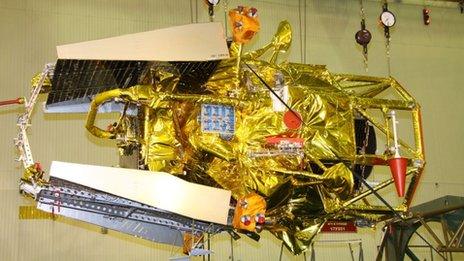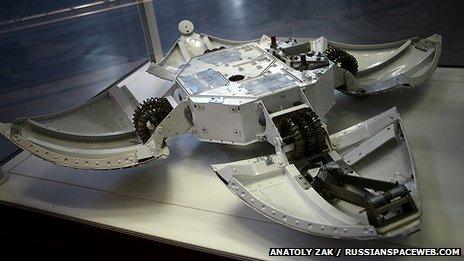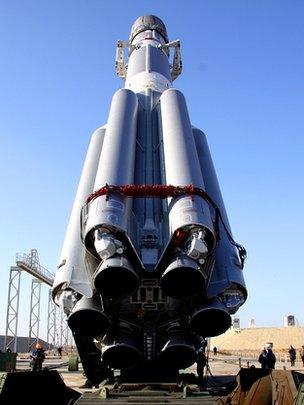What would Mars probe failure mean for Russian space?
- Published

Russia is attempting to revive the wayward spacecraft, but hopes are not high
As Russian hopes of reviving the stranded Phobos-Grunt space probe fade, the nation's entire planetary exploration programme for the next decade hangs in limbo.
Designed to bring samples of ancient soil from the mysterious Martian moon Phobos, the spacecraft got stuck in low-Earth orbit immediately after its launch on 9 November.
If all attempts to restore the contact with the probe fail, Russian scientists, and many of their colleagues abroad, would lose a unique opportunity for planetary research, for which they have been preparing for almost two decades, external.
Even worse, Phobos-Grunt served as a flagship for the Russian planetary exploration programme, intended to pave the way for an array of unmanned missions to many corners of the Solar System, including the Moon, Mars, Venus, Mercury and even moons of Jupiter.

Russia has set its sights on the Red Planet, alongside other targets
Obviously, it is very early to predict how the Phobos-Grunt fiasco would affect the future of the Russian space program, however the nation's scientists had already started looking for ways out of the crisis.
"My immediate reaction [to the possible loss of Phobos-Grunt] was I'd do anything to repeat it," says Aleksandr Zakharov, a leading specialist at the Moscow-based Space Research Institute, IKI, which develops and oversees the nation's planetary exploration projects.
"There are many advantages in this: we have all the blueprints and don't need to develop anything from scratch, we just have to re-build the vehicle, obviously taking into consideration all the mistakes…"
Irons in the fire
The relative motion of Earth and Mars brings the two planets into the vicinity of each other in slightly more than two years.
Dr Zakharov ruled out the possibility of re-building the spacecraft by the next available window for missions to Mars in 2013. However, the next opportunity in 2016 could be met easily, given proper funding, he says.
"However at this point, this is just an emotional calling, which is not based on any (funding or decision)," Dr Zakharov conceded.
In the meantime, another option for jump-starting the Russian exploration of Mars had emerged just weeks before the ill-fated launch of Phobos-Grunt.
Facing financial problems, the European Space Agency (Esa) asked Russia to provide a powerful Proton rocket to launch the first phase of a joint US-European ExoMars project in 2016.
In exchange, Russia would become a full partner in the programme, with the ability to use a large European orbiter to carry its hardware to the vicinity of Mars and, possibly, to the surface of the Red Planet.

Russian landing hardware built for the Mars-96 mission could be used again
On Monday, Oleg Korablev, a leading Russian planetary scientist at the IKI met with the members of the Space Council of the Russian of Academy of Sciences (RAN), seeking an endorsement of Russia's involvement in the ExoMars project.
The council's opinion on the scientific value of the Russian participation would be critical for the subsequent decision of the Russian government to make a multi-million dollar acquisition of the Proton rocket.
Dr Korablev said that his team had prepared two different proposals for possible Russian participation, presented to European colleagues on Friday.
"We intend to propose a minimum programme and the maximum programme," Dr Korablev told BBC News, "In both cases, we are offering instruments for the orbiter, based on our experiments installed on previous US and European spacecraft." However Russian scientists hope to make the biggest impact on the landing phase of the 2016 ExoMars mission.
According to the original plan, the orbiter would carry a European-built lander, which would touchdown on Mars. Built on a limited budget and powered by a battery only, the 700kg spacecraft was not expected to survive on the freezing surface beyond four days. However, now Russian scientists are looking at taking over the landing.
Multiple landings
Dr Korablev says that Russia would offer as many as four landers of two different designs to ride along with ExoMars in 2016. IKI scientists have two off-the-shelf landing stations, which are designed to work on the Martian surface.
They were first developed for the previous Russian project, Mars-96, but were lost in a botched launch in November 1996. That failure was followed by a 15-year break in Russian exploration of the Red Planet.

The 2016 orbiter would look for trace gases like methane in the atmosphere of Mars
One of the Russian landers would use an exotic inflatable heat shield to penetrate the thin Martian atmosphere and make a hard landing without the help of parachutes or rocket engines. A small 20kg weather station is expected to survive the landing to study Martian climate.
Another legacy Russian scientists hope to revive from the Mars-96 project, would be an octagonal platform with a flower-like petals opening after a touchdown inside of inflatable airbags, in a similar fashion that Nasa employed to deliver the now famous Sojourner, Spirit and Opportunity rovers to Mars.
The petal design enables the lander to open and place itself upright on the surface from practically any position after the touchdown.
IKI scientists hope to equip the landing stations with a state-of-the-art seismic sensors developed by the French Space Agency (CNES) promising a breakthrough in the understanding of the internal structure of Mars. "We all agree that this instrument is unique, neither us, nor even Nasa has anything like that," Korablev said.
Mutual benefit
Francis Rocard, a leading planetary scientist at CNES and a participant in the Phobos-Grunt project, said that Russian proposals are interesting. "I know that seismometer very well," Rocard said.
"It is probably the best in the world and we are currently working on providing this instrument for the Nasa Insight mission." However, Dr Rocard said that the instrument was quite expensive, fragile and required an adequate power supply to operate. "All this could be studied," Rocard said.

Russia could provide the Proton rocket for a joint mission - depending on the council's decision
According to Rocard, Esa would have a number of challenging but solvable technical problems in integrating multiple landers into the design of ExoMars orbiter. It could require as much as four days during the mission to conduct a separation of each lander from the spacecraft fast approaching Mars.
The first of landers would have to be jettisoned with extremely high precision in order to reach Mars as long as 16 days before the closest approach to the planet of the main spacecraft.
"It is challenging but it is manageable," Dr Rocard said, "two landers are manageable easily but four? I don't know, they (Esa) have to answer this."
Technical problems aside, Rocard said that the Russian decision to provide the Proton rocket would be the only way to save the entire ExoMars mission in 2016, but also much more ambitious and challenging plan to place a large life-seeking rover on the surface of the Red Planet in 2018.
Even though Nasa had promised to provide a rocket for that launch, the rover would need the European orbiter launched in 2016, in order to communicate with ground control. Still, Russian scientists stood to benefit too, especially after the Phobos-Grunt fiasco.
"I think it could be a good opportunity for the Russians to start again, rapidly on a new mission, less ambitious than Phobos-Grunt, but in a joint mission with a mutual benefit," Rocard concluded.
- Published11 November 2011
- Published10 November 2011
- Published14 October 2011
- Published20 September 2011